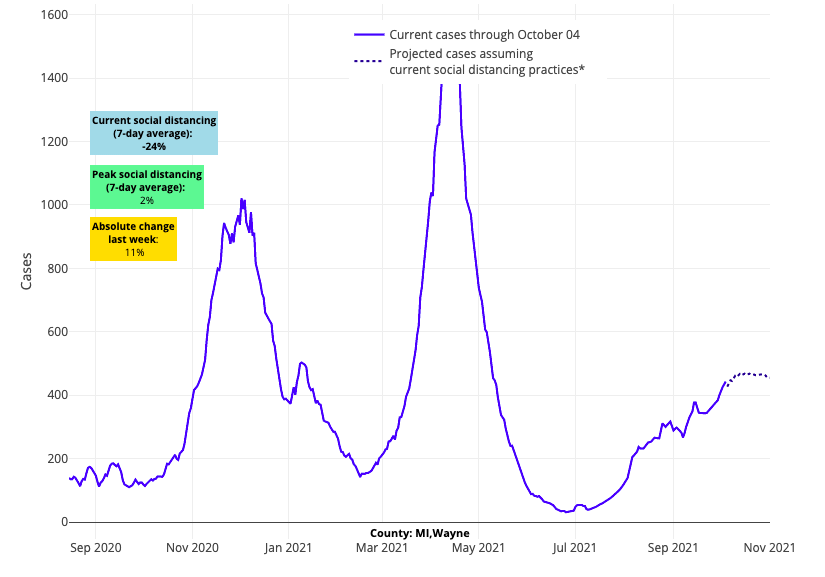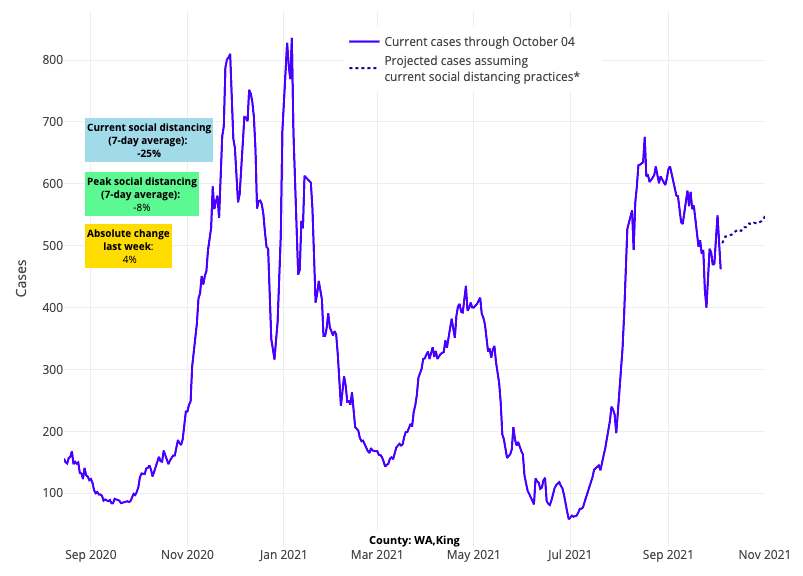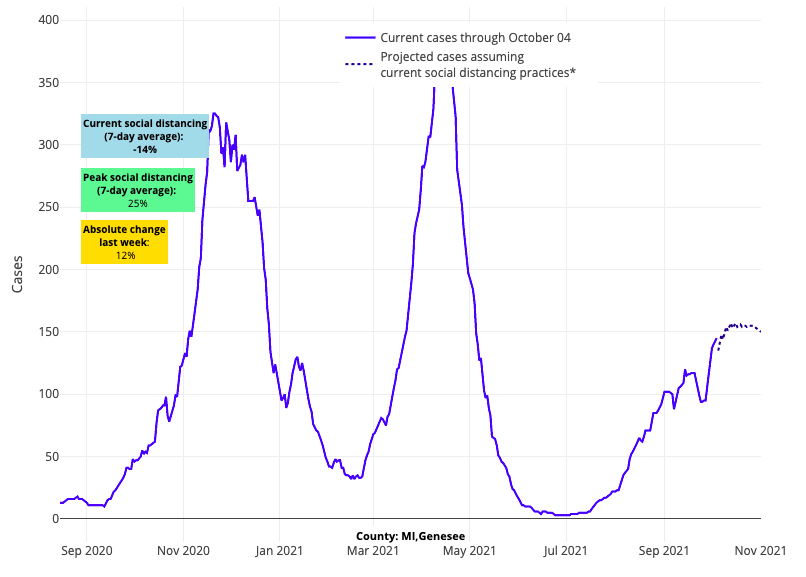COVID-19 Outlook: We Haven’t Yet Turned the Corner in the North

Following another weekly update to our COVID-Lab forecasting model, here are some top-line findings from the latest national COVID-19 data:
- The average PCR test positivity rate across the 813 counties included in our model this week is 9.8%, down from 10.4% last week. Still, a majority of the counties we’re following have a test positivity rate over 9%. The 10 states with the largest increases in test positivity include Colorado, Delaware, Michigan, Minnesota, Montana, New Mexico, North Dakota, Utah, West Virginia and Wisconsin.
- While average reproduction numbers (a measure of transmission that estimates how many additional individuals, on average, will be infected by every positive case) across the counties we’re monitoring is 0.88 (indicating declining transmission), 1 in 5 counties—concentrated mostly in the Upper Midwest—have reproduction numbers above 1.
- Adult hospital census has fallen to around 60,000 patients, down from nearly 100,000 just a few weeks ago. Pediatric hospital census has fallen below 1,200 patients, down from a high of 1,600 a few weeks ago.
Here are some updates from regions we have been monitoring:
- Several counties across Michigan saw increases in case incidence this week, and our forecasts show continued growth in case incidence throughout the state over the next four weeks. This growth has been accompanied by increasing adult and pediatric hospital admissions.

Above are the projections for Wayne County in Michigan.
- Counties across Idaho have experienced their most difficult moments of the pandemic over the last few weeks, with case incidence and hospitalizations that have exceeded those of last winter. However, as the test positivity rate begins to decline in the state, our models forecast these areas will move past peak transmission within the next couple of weeks.
- Most counties throughout the New York City metropolitan area have had significant drops in case incidence over the last couple of weeks, which our projections show will continue through the month, even as other areas in northern New England, such as Massachusetts, have seen steady transmission and hospitalizations since early September.
- While no longer seeing an increase in cases, the Pacific Northwest, particularly Seattle, continues to experience persistently elevated case incidence that has not abated since Labor Day. Our models forecast a continuation of sustained case incidence in this region for the next four weeks.

Above are the projections for King County (Seattle) in Washington.
The Northeast Should Take Notice: The Upper Midwest and Mountain States Have Not Turned the Corner
We expressed some optimism in our blog post last week that more highly vaccinated states throughout the Upper Midwest and Northeast were proving resilient against resurgent COVID-19-related hospitalizations among adults and children at the start of fall. With swiftly improving hospitalizations and transmission in the South and West, the country as a whole was experiencing steep declines in case incidence and hospitalizations following a difficult end to summer.
In the data this week, we see declines beginning to stall in many counties out West, and while the Northeast remains relatively unchanged, many northern areas are slightly worse this week. Case incidence has remained stubbornly high in the Upper Midwest and across the Mountain States, and we are seeing new evidence of increasing rates across New Mexico into Arizona. Counties throughout Alaska, Idaho, Montana, North Dakota, Utah and Wyoming—all states with lower vaccination coverage—have already demonstrated that the risk to poorly vaccinated regions has remained substantial as days shorten and colder conditions force people back indoors. Montana, like Idaho and Alaska, is being tested like no other moment in the pandemic, with hospitalization rates that now exceed last winter’s peaks.

The above graph shows daily COVID-19 cases and hospital census per 100,000 people in Montana.
There is also growing concern for Michigan, which had been trailing other states in the region in COVID-19 impacts over the last couple of months, due to what we suspect was higher population immunity from a late winter surge earlier this year. In the last two weeks, case incidence has picked up again throughout the state and hospitalization rates are increasing among both adults and children. Genesee (Flint), Macomb, and Wayne (Detroit) counties have been bellwethers for the state of Michigan in prior waves, and all are now experiencing rising cases once again, with forecasts showing potential for continued increases in case incidence in the coming weeks.

Above are the projections for Genesee County in Michigan.
Hospitalizations are also increasing in Minnesota and Wisconsin after experiencing what appeared to be a plateauing rate in recent weeks. Pediatric hospitalizations are growing at a similar pace in Minnesota to Michigan, illustrating that unvaccinated children in that region remain at higher risk for additional hospitalizations throughout the fall.
Even as many highly vaccinated northeastern states (with many areas reporting more than 80% of adults vaccinated) continue to be stable, we would remind our readers that the Northeast did not experience a significant surge last year until the holiday season in November and December. We will continue to watch the Northeast closely over the next eight weeks, as that period of time should give us a better understanding of the benefits of community-level protection from higher vaccination rates during colder periods.
While the month of October is shaping up to be a respite from COVID-19 in many parts of the country—particularly across the South—the holidays are quickly approaching. Case incidence increased rapidly just after Halloween last year and surged through the New Year—this remains foremost on our minds. While the degree of protection from population immunity for the upcoming winter is still yet to be determined, we expect that higher population immunity from vaccination and natural infection will result in less of a surge this year as compared to last. However, for areas with lower vaccination rates, the potential for another period of resurgence remains high.
As we have noted repeatedly in recent weeks, the current state of the pandemic is being dictated at the regional level. There is still time for communities to maximize vaccinations among children and adults so that we can prevent local surges in all regions this winter and finally move toward the waning days of the pandemic.

